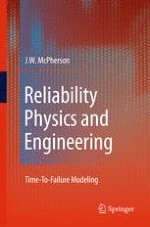2010 | OriginalPaper | Buchkapitel
12. Time-To-Failure Models for Selected Failure Mechanisms in Mechanical Engineering
verfasst von : J.W. McPherson
Erschienen in: Reliability Physics and Engineering
Verlag: Springer US
Aktivieren Sie unsere intelligente Suche, um passende Fachinhalte oder Patente zu finden.
Wählen Sie Textabschnitte aus um mit Künstlicher Intelligenz passenden Patente zu finden. powered by
Markieren Sie Textabschnitte, um KI-gestützt weitere passende Inhalte zu finden. powered by
